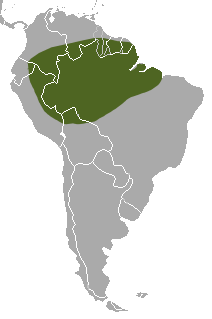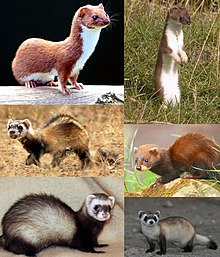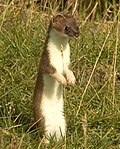
The Mustelidae are a diverse family of carnivorous mammals, including weasels, stoats, badgers, otters, martens, grisons, and wolverines. Otherwise known as mustelids, they form the largest family in the suborder Caniformia of the order Carnivora with about 66 to 70 species in nine subfamilies.

The stoat, also known as the Eurasian ermine, Beringian ermine and ermine, is a mustelid native to Eurasia and the northern regions of North America. Because of its wide circumpolar distribution, it is listed as Least Concern on the IUCN Red List. It was introduced into New Zealand in the late 19th century to control rabbits, but had a devastating effect on native bird populations and was nominated as one of the world's top 100 "worst invaders".

The long-tailed weasel, also known as the bridled weasel, masked ermine, or big stoat, is a species of mustelid distributed from southern Canada through much of the United States and Mexico, southward through all of Central America and into northern South America. It is distinct from the short-tailed weasel, also known as a "stoat", a close relation in the genus Mustela that originated in Eurasia and crossed into North America some half million years ago; the two species are visually similar, especially the black tail tip.

The least weasel, little weasel, common weasel, or simply weasel is the smallest member of the genus Mustela, family Mustelidae and order Carnivora. It is native to Eurasia, North America and North Africa, and has been introduced to New Zealand, Malta, Crete, the Azores, and São Tomé. It is classified as least concern by the IUCN, due to its wide distribution and large population throughout the Northern Hemisphere.
In Japanese folklore, tsukumogami are tools that have acquired a kami or spirit. According to an annotated version of The Tales of Ise titled Ise Monogatari Shō, there is a theory originally from the Onmyōki (陰陽記) that foxes and tanuki, among other beings, that have lived for at least a hundred years and changed forms are considered tsukumogami. In modern times, the term can also be written 九十九神, to emphasize the agedness.

The Amazon weasel, also known as the tropical weasel, is a species of weasel native to South America. It was first identified from a museum specimen mislabelled as coming from Africa, hence the scientific name.

Kamaitachi (鎌鼬) is a Japanese yōkai from the oral tradition of the Kōshin'etsu region. It can also refer to the strange events that this creature causes.

Kasa-obake are a mythical ghost or yōkai in Japanese folklore. They are sometimes, but not always, considered a tsukumogami that old umbrellas turn into. They are also called "karakasa-obake" (から傘おばけ), "kasa-bake" (傘化け), and "karakasa kozō" (唐傘小僧).

The kuda-gitsune or kuda-kitsune, also pronounced kanko, is a type of spirit possession in legends around various parts of Japan. It may be known otherwise as osaki especially in the Kantō region, and also considered equivalent to the izuna.

Amefurikozō is a type of Japanese yōkai. There is a depiction of this yōkai in Sekien Toriyama's collection of yōkai drawing the Konjaku Gazu Zoku Hyakki, and they can also be seen in the kibyōshi among other publications of the same era.

Abura-akago is a Japanese type of infant spirit or ghost. It is a yōkai that appeared illustrated in Toriyama Sekien's mid-Edo period Konjaku Gazu Zoku Hyakki, as an infant spirit lapping oil out of an andon lamp.

The Japanese marten is a marten species endemic to Japan.

The Colombian weasel, also known as Don Felipe's weasel, is a very rare species of weasel only known with certainty from the departments of Huila and Cauca in Colombia and nearby northern Ecuador. Both its scientific and alternative common name honours the mammalogist Philip "Don Felipe" Hershkovitz.

Mikoshi-nyūdō is a type of bald-headed yōkai "goblin" with an ever-extending neck. In Japanese folklore and Edo period (1603–1868) kaidan "ghost story" texts, mikoshi-nyūdō will frighten people who look over the top of things such as byōbu folding screens. The name combines mikoshi見越し "looking over the top ; anticipation; expectation" and nyūdō入道 "a (Buddhist) priest; a bonze; a tonsured monster".

The Nuribotoke (塗仏) is a yōkai found in Japanese yōkai emaki such as the Hyakkai Zukan by Sawaki Suushi. They are also depicted in the Gazu Hyakki Yagyō by Toriyama Sekien.

Tenome is a Japanese yōkai that appeared in the Gazu Hyakki Yagyō by Toriyama Sekien.
Hito-gitsune or ninko is a type of spirit possession told about in legends of the Chūgoku region of western Japan.

Weasels are mammals belonging to the family Mustelidae and the genus Mustela, which includes stoats, least weasels, ferrets, and minks, among others. Different species of weasel have lived alongside humans on every continent except Antarctica and Australia, and have been assigned a wide range of folkloric and mythical meanings.

The ouni (苧うに) is a yōkai depicted in the Gazu Hyakki Yagyō by Toriyama Sekien.

Neogale is a genus of mustelid native to the Americas, ranging from Alaska south to Bolivia. Members of this genus are known as New World weasels.



































